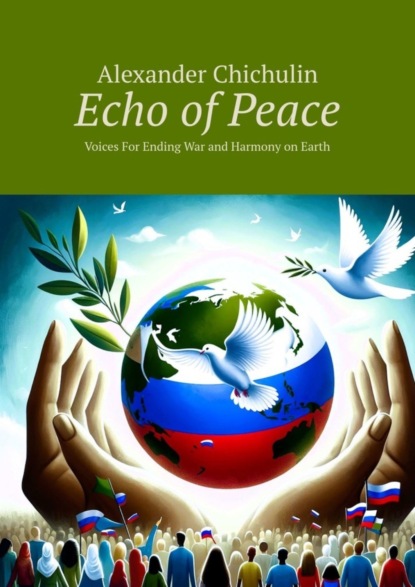По всем вопросам обращайтесь на: info@litportal.ru
(©) 2003-2025.
✖
Echo of Peace. Voices For Ending War and Harmony on Earth
Настройки чтения
Размер шрифта
Высота строк
Поля
Mandela’s strong point was his belief that true peace is possible only through forgiveness and mutual respect, even after years of oppression and struggle. He called not only for political and social change, but also for profound personal transformation as a means of overcoming deep-rooted prejudice and hatred.
His words and actions have become a powerful example of how to overcome deep divisions and strive for a shared future based on equality, justice and cooperation. Mandela showed that even the most difficult and painful conflicts can be overcome through wisdom, compassion and determination in the pursuit of peace and justice.
The Long Road to Freedom doesn’t just tell Mandela’s personal story, it tells the story of the need to fight for human dignity and freedom around the world. This work remains a source of inspiration for all those who strive for peace, equality and harmony in society.
Mother Teresa: «Simple Paths to Peace»
Mother Teresa, known for her selfless love and concern for the most vulnerable segments of society, shares her vision in her speech «Simple Paths to Peace» about how even the smallest acts of love and care can make a huge difference in creating peace and harmony in the world.
She said that the world begins with every individual, every heart, and every home. In her opinion, simple actions such as a smile, a kind word, attention and compassion for others can radically change the atmosphere around us and create waves of positive changes in society.
Mother Teresa is convinced that everyone, regardless of their social status, age or profession, has the ability to contribute to the creation of a peaceful world. She calls for active love and care, emphasizing that it is in small actions that the true power to change the world lies.
Her words remind us that peace is not necessarily built through big political agreements or international agreements, but also through the daily actions of ordinary people. Kindness, care, respect and compassion are the basic building blocks that can build a peaceful and harmonious society.
Mother Teresa’s» Simple Paths to Peace – is a reminder that each of us has the power to influence the world around us, and that it is in our hands to create a world dominated by love and care. Her words and actions continue to inspire people around the world to do good deeds and strive for peace in their daily lives.
_____
Each of these speeches carries a unique vision of the world and the way to achieve it. They remind us that peace is not just an ideal that we strive for, but a path that we choose every day with our thoughts, words and actions.
In this section, we not only reproduce the texts of these inspiring speeches, but also try to understand and comprehend the depth and essence of their messages. These voices of peace are the lights that light up our path to a brighter and more peaceful future.
Section 2: History Lessons
In this section, we dive into history to explore examples of successful peace initiatives. These examples show us that even in the most difficult and seemingly hopeless situations, it is possible to find ways to achieve peace and harmony.
· Review historical examples of successful peace initiatives
Congress of Vienna (1814—1815)
Description: After the Napoleonic Wars, representatives of the leading powers of Europe gathered to redraw the map of the continent and prevent future conflicts.
Lessons learned: The Vienna Congress has become an example of international diplomatic cooperation, demonstrating that dialogue and compromise can be more effective than military confrontation.
Treaty Banning Nuclear Tests in the Atmosphere, in Space and Under Water (1963)
Description: At the height of the Cold War, the Soviet Union, the United States, and Britain signed a treaty significantly limiting nuclear testing.
Lessons learned: This treaty was an important step towards limiting nuclear weapons and demonstrating that even in the face of global confrontation, dialogue and cooperation are possible for the sake of common security.
Northern Ireland Peace Agreement (1998)
Description: The famous «Good Friday Agreement» that ended decades of conflict in Northern Ireland.
Lessons learned: This agreement shows how a long and bloody conflict can be resolved through negotiations, taking into account the interests of all parties and recognizing the importance of peaceful coexistence of different cultural and political groups.
The breakup of Yugoslavia and the Role of the UN in Conflict resolution (1990s)
Description: The complex process of disintegration of Yugoslavia was accompanied by numerous ethnic conflicts and humanitarian crises.
Lessons learned: The intervention of the UN and other international organizations has helped reduce tensions and prevent further casualties, highlighting the importance of international cooperation in conflict resolution.
Anti-apartheid movement in South Africa
Description: A long struggle against the system of racial segregation in South Africa, which ended with peace talks and elections.
Lessons learned: This example shows how peaceful resistance and relentless struggle for rights and freedoms can lead to significant social change and justice.
These historical examples demonstrate that, despite differences in culture, history, and political conditions, peaceful resolution of conflicts is possible and preferable. They serve as a reminder that history does not have to repeat itself, and that the lessons of the past can be the foundation for a more peaceful future.
· Discuss mistakes and lessons from past conflicts
Studying the history of peace efforts also includes analyzing mistakes made in past conflicts. This helps us learn lessons and avoid repeating past mistakes in the future.
Lack of Communication and Misunderstanding
Example: The Cold War was a period when distrust and hostility between the United States and the Soviet Union resulted in an arms race and political confrontation.
Lessons learned: The importance of open dialogue and trying to understand the other party’s motivations and fears. Reducing tensions and resolving conflicts often starts with improving communication and mutual understanding.
Ignoring Cultural and Ethnic Differences
Example: Conflicts in the former Yugoslavia were partly caused by a failure to take into account and respect different ethnic and cultural identities.
Lessons learned: The need to recognize and respect diversity and differences. Peaceful coexistence is possible only if the rights of all cultural and ethnic groups are recognized and protected.
Delayed International Response
Example: The 1994 Rwandan Genocide, when the international community failed to respond quickly and effectively to prevent the tragedy.
Lessons learned: The importance of timely and decisive action by the international community in preventing humanitarian crises.
Peacekeeping Operations Policy
Example: The complexity of UN peacekeeping operations in various regions, including Somalia and Bosnia.
Lessons learned: The need for a clear mandate, sufficient resources, and a deep understanding of local conditions for effective peacekeeping.
Inequality and Social Injustice
Example: Apartheid in South Africa demonstrates how systematic inequality and discrimination can lead to prolonged conflict.
Lessons learned: Justice and equity are essential elements of a sustainable world. The solution of social and economic problems is inseparable from the process of achieving peace.
These mistakes and lessons from past conflicts show us that peace is not only the absence of war, but also the active pursuit of understanding, respect, justice and equality. Given these lessons, we can build a more peaceful future based on respect, tolerance and cooperation.
Start of the form











